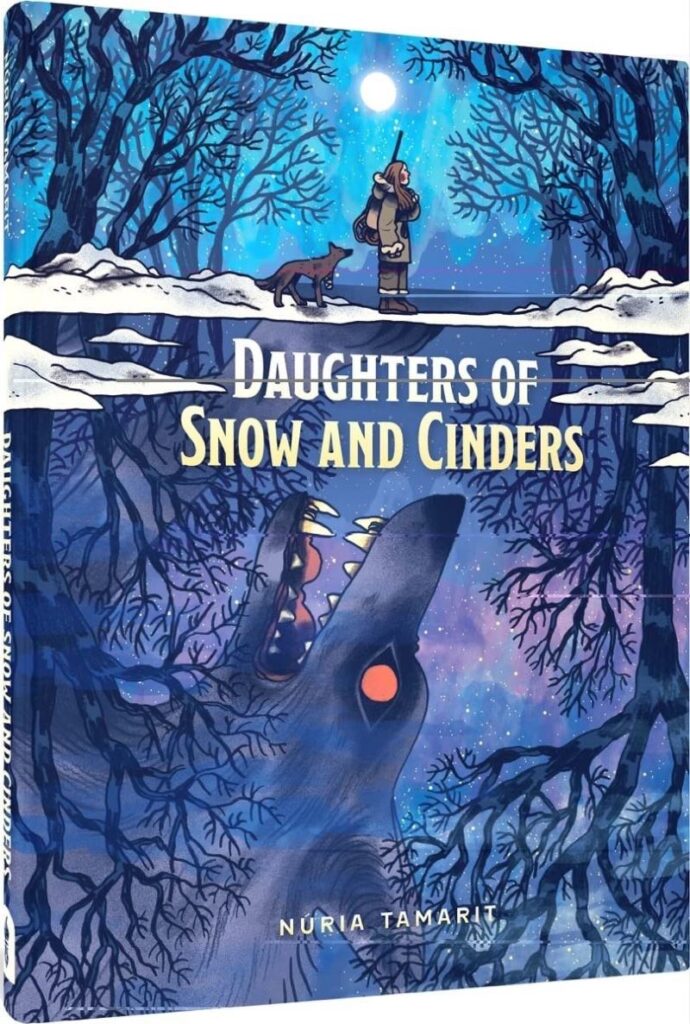
When a determined young adventurer sets out into the wilderness in search of gold, she quickly encounters threats from the elements, other prospectors, and a fearsome gigantic beast. Núria Tamarit’s new graphic novel tracks Joana’s path from the fringes of frontier society to the icy heart of the wilderness, gradually revealing surprising compatriots along the way.
Joana finds herself in the New World as a result of tragedy at her ancestral Nordic home. With no prospects for financial salvation at home, she travels across the globe with the faint hope that she may be able to find enough gold to bring home to restore her estate and her future. When her intended traveling party takes off without her, she steels herself to follow silently in their wake, hoping to survive the harsh conditions long enough to reach the gold territory behind them.
Although the story appears to be centered solely on Joana, the plural in its title hints that it slowly expands to incorporate the tales of two indigenous women who also have fire-related tragedy in their pasts. Elderly Opa and young Tala are begrudgingly helping the band of white male prospectors, cast into positions of unwanted servitude as they search for any chance to escape. As Tamarit’s story races to its thrilling conclusion, it plays up feminist themes of the three women standing up for themselves, banding together, and rejecting the idea that the men are superior in any way.
At first glance, Tamarit’s drawing style appears deceptively simple, with bulbous characters reduced to such basic elements that they only have dots for eyes. However, she proves to be a master of color theory, splashing her vibrant tapestry with hues that enhance the mood of each scene. Frosty night scenes are colored with dark purples and blues, juxtaposed against flashbacks to the pastoral greens of Joana’s Nordic youth, fiery reds of its tragic end, and warm pinkish oranges of a romantic afternoon liaison. Also, her landscapes are richly detailed and frequently called into high relief with spectacular splash pages that demand to be savored before proceeding with the story. While the character models may seem a bit cartoony and oversimplified for a deadly serious wilderness tale, Tamarit’s overall visual presentation is highly impressive.
Strangely, Joana and all three indigenous characters are portrayed with flaws on the right side of their head. Joana bears a large birthmark on her cheek, while all of the natives have lost their right eyes, with the elderly Opa also carrying burn scars around the area and male tracker Semiov bearing animal claw marks. There’s no explanation given for this distinction, but it symbolically serves to identify them as members of the same side in their ongoing skirmishes with the unblemished white men.
Although Tamarit is a Spanish cartoonist, she seems to have a thorough grasp of the legacy of our treatment of indigenous people throughout North America. While her story doesn’t specifically identify a country, the snowy setting points to Klondike or Yukon gold rushes, while the theme of white men exploiting natives is obviously universal. It’s interesting to see our history framed from the perspective of an outsider, but it’s also such a timeworn topic that it pales in comparison to her gradual elevation of feminism as the primary narrative strength.
Tamarit also dips her toe into the mystical with the incorporation of a massive wolf recurring throughout the book, rendered so big it doesn’t appear to be physically possible. Is it really a huge beast pursuing our heroes, is it a normal wolf that appears larger through fear, or does it simply represent the vast danger posed by the winter elements? Tamarit doesn’t definitively tell us, leaving it open to interpretation and adding a pleasant dollop of whimsy into her otherwise grounded tale.
Tamarit is a fairly young cartoonist but is already operating at a superior level. This book is her most expansive solo work to date, establishing her as a name to watch in the years to come. Fantagraphics presents the book in a beautiful oversized hardcover format, allowing readers to thoroughly enjoy the captivating art.